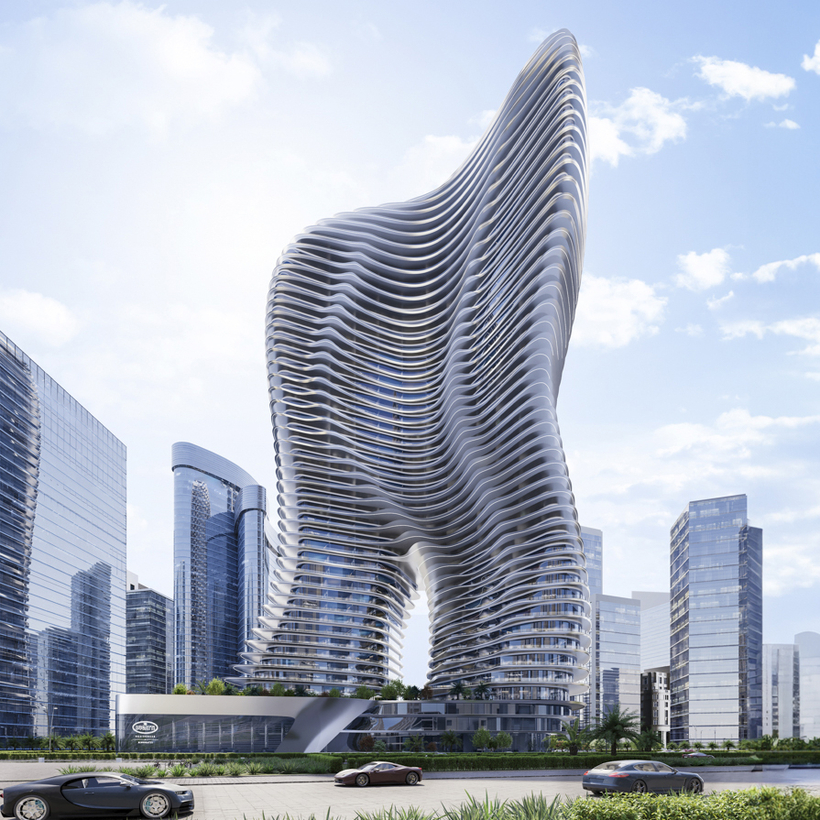As an 11-year-old, I tried to convince my mother that we should sell our Victorian farmhouse in the rolling English countryside and pour nearly every dime into a brand-new Jaguar XJ220, which was capable of speeds up to 212 m.p.h. and cost nearly $700,000 at the time. We would live simply inside this low-slung, two-seat supercar, parked at a rest stop with a washing line hung between the car and any nearby tree.
Now a much more comfortable alternative has arisen. Prestige-car manufacturers are racing to build luxury residential towers in moneyed enclaves around the world.

A few weeks ago, in Dubai, I stared at a big hole in the ground. Local developer Binghatti has commenced construction of a 43-story condominium in collaboration with performance-car maker Bugatti. Renderings of the building reveal a design with fluid lines and shapes that shift and swell in the light like a lava lamp (or which, from some angles, look like the back end of an elephant). The tower is said to have been inspired by the French Riviera, and will have an artificial beach club—an elevated pool terrace styled as if it were in Antibes or Cassis, and with golden sand imported from a real beach.

Nearby, and with a few months’ head start, Binghatti is building a 65-story tower with Mercedes. It’s a futuristic phallic design that’s capped with an arch, clad in solar panels, and covered with a plethora of illuminated three-pointed stars similar to the car company’s logo. Mercedes-Benz Places, as it’s being called, will offer a private outdoor pool with every apartment (as will Bugatti) and unobstructed views of the world’s tallest building, the Burj Khalifa. Two-bedroom apartments at Mercedes-Benz Places and Bugatti Residences start at $2.4 million and $5.2 million, respectively. A triplex in either tower (up to 47,000 square feet) is listed at an astonishing $204 million.
C.E.O. and architect Muhammed Binghatti is a petrolhead. He has a Bugatti on order that is so exclusive the model hasn’t even been announced yet. (Bugatti’s cheapest car is around $3.3 million.) He says he can identify any sports car from a mile away. “It’s the same with fashion and watches,” he says, a Jacob & Co. x Bugatti Chiron Tourbillon jutting from under the cuff of his white dishdasha. “I’m trying to do the same with architecture and real estate. We need children to point to our buildings. We want to create super-buildings that evoke emotions from a five-year-old.”

Dubai is not the trendsetter here. In fact, the U.A.E. city is almost 10 years behind Miami. The first of these buildings to arrive on the scene was the Porsche Design Tower, on Sunny Isles Beach, completed in 2017. It has elevators that allow a resident to sit behind the wheel of their car as they ascend the 641-foot tower, and then park directly outside their apartment. (The Bugatti property has a similar system, but only for some penthouses.)

Later this year, Aston Martin Residences will open its doors to the downtown Biscayne Bay waterfront. Sixty-six stories tall, it has a helipad on the roof and Aston Martin claims it has the highest swimming pool in Florida. The developer says that 98 percent of the 391 units are already sold. The triplex penthouse is listed for $59 million, but the price is rising as prospective tenants outbid one another. And it comes with one of Aston Martin’s preciously scarce Vulcans—the company has produced just 24. The track-only hypercar (a level above a supercar) is currently valued at around $3.5 million.
In each case, these towers have come about because a major developer approached a car manufacturer, rather than the other way around. Once the developer has convinced the car-maker of the project’s location, worth, and integrity, an architectural firm is hired. This is paid for by the developer, who also funds all the construction costs and buys the land on which the tower will sit. The car company’s main investment is its brand and its time. Architects work with the car-maker’s in-house design team to create a building whose every inch is in tune with the DNA of its four-wheeled cousins. In addition to the branding, the car company takes a cut of the profits.

The triplex penthouse comes with one of Aston Martin’s preciously scarce Vulcans—the company has produced only 24.
As Binghatti notes, the car-makers can be demanding. “They don’t venture outside of manufacturing cars very often,” he says. “Our workshops … are like history lessons.”
“And they’re super-protective, very territorial.”

Aston Martin’s chief creative officer, Marek Reichman, has been especially involved in the Aston Martin Residences project. “They [Miami-based developer G&G] called me about doing some residences, to which I said, ‘No, sorry, we just do cars. Bye,’” he says. “But they were pretty persistent.”
“The criteria I put forward was that I would work directly with the architect, and I wanted full control of the touch points that represent Aston Martin. I’m not an architect, but I didn’t want Rodolfo Miani, who is the architect, to go away, design a building, and say, ‘What do you think?’ I wanted to be sitting with him from the first sketch [to the last]. There needs to be synergy. And, of course, there was.”
The result is a tall, curved glass building that stretches back from the headland. It’s a cross between an up-ended Aston Martin radiator grille and an elegant airfoil, which is useful given the fierce winds that can rip across the bay. Everything, Reichman says, is designed with the feeling of an Aston Martin, “even down to the car-ramp angles. If you drive a Porsche or Ferrari up there, you’ll have to go a bit slower because the approach angle is different.”
“If you’re an Aston Martin owner … it feels like you fit. And, because of the high value of the residences, it’s perfect for our consumer group,” Reichman says.

Bentley has seen the appeal, too. Located a couple of doors down from the Porsche tower and built by the same developer, Dezer, Bentley Residences broke ground on February 26 of this year. It promises to be jewel-like, the diamond being one of the car-maker’s signatures, as it’s built from faceted glass in which each panel is at an angle. And the materials you find in a Bentley—all that wood, leather, and metal—are also on display in the building.

The Bentley Residences will have the same car elevators as its neighbor, though you don’t have to drive a Bentley. “It’s a broad church,” says Bentley’s head of brand partnerships, James Pillar. “They’re buying it for the brand, the aesthetics, the quality, on its own merit. So, we welcome all, and we would love to turn more real-estate customers into car customers as a result, of course.”
Will there be a dealership on the ground floor in case the urge strikes them? “The appeal is, it’s not a commercial property. This is a home. It would be inappropriate to have a showroom.”
“This is not ‘car guys designing car things for car guys,’” continues Pillar. “These have been designed to look beautiful in [their] own right.”
New car models are only required to look fresh for six years before being redesigned, and companies regularly update their visual identity. So, it’s quite an undertaking to commit to something that needs to appear sleek and relevant for the next 50 years.

“The designers are very conscious of that burden, that this is forever,” notes Pillar. “They’re very conscious of quality and design integrity, not necessarily following a fashion but being true to the design philosophy that Bentley stands for.”
More accommodating than the grandest of grand tourers, but with a sense of occasion that only comes from the finest of automotive icons, these buildings mark a profitable niche high above the highways for the world’s best car-makers.
Adam Hay-Nicholls is the author of Charles Leclerc: A Biography and Smoke & Mirrors: Cars, Photography and Dreams of the Open Road


